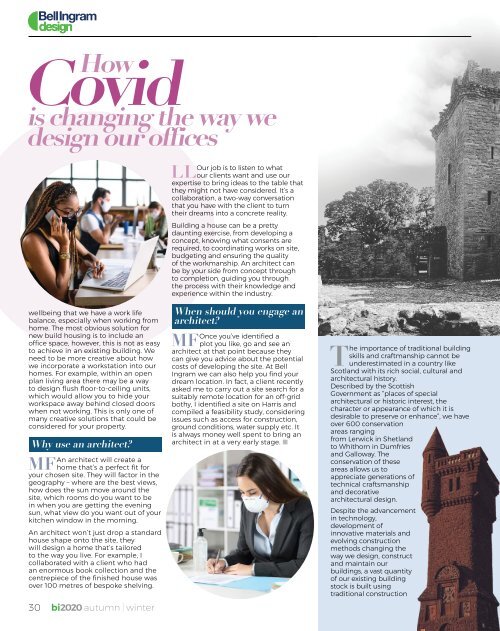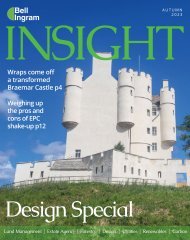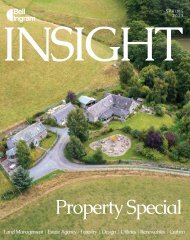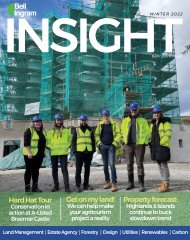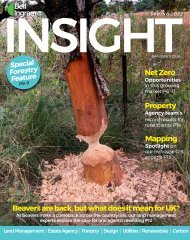Create successful ePaper yourself
Turn your PDF publications into a flip-book with our unique Google optimized e-Paper software.
design<br />
Covid<br />
How<br />
is changing the way we<br />
design our offices<br />
wellbeing that we have a work life<br />
balance, especially when working from<br />
home. The most obvious solution for<br />
new build housing is to include an<br />
office space, however, this is not as easy<br />
to achieve in an existing building. We<br />
need to be more creative about how<br />
we incorporate a workstation into our<br />
homes. For example, within an open<br />
plan living area there may be a way<br />
to design flush floor-to-ceiling units,<br />
which would allow you to hide your<br />
workspace away behind closed doors<br />
when not working. This is only one of<br />
many creative solutions that could be<br />
considered for your property.<br />
Why use an architect?<br />
An architect will create a<br />
MF home that’s a perfect fit for<br />
your chosen site. They will factor in the<br />
geography – where are the best views,<br />
how does the sun move around the<br />
site, which rooms do you want to be<br />
in when you are getting the evening<br />
sun, what view do you want out of your<br />
kitchen window in the morning.<br />
An architect won’t just drop a standard<br />
house shape onto the site, they<br />
will design a home that’s tailored<br />
to the way you live. For example, I<br />
collaborated with a client who had<br />
an enormous book collection and the<br />
centrepiece of the finished house was<br />
over 100 metres of bespoke shelving.<br />
Our job is to listen to what<br />
LL our clients want and use our<br />
expertise to bring ideas to the table that<br />
they might not have considered. It’s a<br />
collaboration, a two-way conversation<br />
that you have with the client to turn<br />
their dreams into a concrete reality.<br />
Building a house can be a pretty<br />
daunting exercise, from developing a<br />
concept, knowing what consents are<br />
required, to coordinating works on site,<br />
budgeting and ensuring the quality<br />
of the workmanship. An architect can<br />
be by your side from concept through<br />
to completion, guiding you through<br />
the process with their knowledge and<br />
experience within the industry.<br />
When should you engage an<br />
architect?<br />
Once you’ve identified a<br />
MF plot you like, go and see an<br />
architect at that point because they<br />
can give you advice about the potential<br />
costs of developing the site. At Bell<br />
Ingram we can also help you find your<br />
dream location. In fact, a client recently<br />
asked me to carry out a site search for a<br />
suitably remote location for an off-grid<br />
bothy, I identified a site on Harris and<br />
compiled a feasibility study, considering<br />
issues such as access for construction,<br />
ground conditions, water supply etc. It<br />
is always money well spent to bring an<br />
architect in at a very early stage. n<br />
T<br />
he importance of traditional building<br />
skills and craftmanship cannot be<br />
underestimated in a country like<br />
Scotland with its rich social, cultural and<br />
architectural history.<br />
Described by the Scottish<br />
Government as “places of special<br />
architectural or historic interest, the<br />
character or appearance of which it is<br />
desirable to preserve or enhance”, we have<br />
over 600 conservation<br />
areas ranging<br />
from Lerwick in Shetland<br />
to Whithorn in Dumfries<br />
and Galloway. The<br />
conservation of these<br />
areas allows us to<br />
appreciate generations of<br />
technical craftsmanship<br />
and decorative<br />
architectural design.<br />
Despite the advancement<br />
in technology,<br />
development of<br />
innovative materials and<br />
evolving construction<br />
methods changing the<br />
way we design, construct<br />
and maintain our<br />
buildings, a vast quantity<br />
of our existing building<br />
stock is built using<br />
traditional construction<br />
Conservation -The importance<br />
of traditional building skills &<br />
craftsmanship<br />
Lauren Livingston<br />
BSc (Hons) ACIAT<br />
Architectural Technologist<br />
lauren.livingston<br />
@bellingram.co.uk<br />
methods and skilled craftsmanship.<br />
Not only are traditional buildings<br />
constructed in this way but they must also<br />
be maintained and treated with the same<br />
traditional construction methods and<br />
materials.<br />
To many, it may come as a surprise<br />
to learn that research has suggested<br />
that using modern methods of<br />
construction and innovative materials<br />
can actually have adverse effects when<br />
used to repair traditional buildings. In fact,<br />
by changing the aesthetic appearance<br />
and decorative character, we run the<br />
risk of potentially damaging the existing<br />
fabric of a building.<br />
This is concerning as it is becoming<br />
increasingly difficult to find skilled,<br />
traditional tradesmen and women.<br />
With maintenance and repairs to our<br />
traditional buildings accounting for a<br />
large percentage of today’s construction<br />
activity, it is crucial that we retain and<br />
develop our traditional skills to protect,<br />
preserve and repair our built heritage.<br />
Historic Environment Scotland<br />
(HES) and The Prince’s Foundation are two<br />
of a number of organisations that have<br />
recognised the wider need for training and<br />
apprenticeships to prevent precious skills<br />
being lost.<br />
oth organisations should be<br />
congratulated for steering a<br />
Brange of apprenticeship schemes<br />
and informative training courses,<br />
educating and training the next<br />
generation of skilled craftspeople.<br />
It is evident that we must have the<br />
knowledge and training widely available<br />
to prevent future generations losing vital<br />
skills and undertaking maintenance with<br />
contemporary construction methods<br />
which are highly likely to have adverse<br />
effects on our current building stock.<br />
Traditional building skills play a<br />
vital role in protecting our built<br />
heritage while investing in and supporting<br />
our economy. With increasing<br />
concerns about the condition of our<br />
existing building stock, which largely<br />
predates 1919, it is more important than<br />
ever that we have the skill, knowledge and<br />
understanding of our buildings.<br />
If you are looking to undertake any work<br />
to a traditional building, listed building<br />
or a building within the curtilage of a<br />
conservation area, please get in touch<br />
with one of our team and find out how we<br />
can help you with our expertise and key<br />
knowledge within the industry. n<br />
4 bi<strong>2020</strong> winter winter bi<strong>2020</strong> 5<br />
30 bi<strong>2020</strong> autumn ❘ winter autumn ❘ winter bi<strong>2020</strong> 31<br />
design


